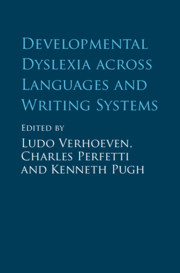Book contents
- Developmental Dyslexia across Languages and Writing Systems
- Developmental Dyslexia across Languages and Writing Systems
- Copyright page
- Contents
- Figures
- Tables
- Contributors
- 1 Introduction
- Part I Developmental Dyslexia across Languages and Writing Systems
- 2 Developmental Dyslexia in English
- 3 Developmental Dyslexia in French
- 4 Developmental Dyslexia in Dutch
- 5 Developmental Dyslexia in Czech and Slovak
- 6 Developmental Dyslexia in Finnish
- 7 Developmental Dyslexia in Russian
- 8 Developmental Dyslexia in Hebrew
- 9 Developmental Dyslexia in Japanese
- 10 Developmental Dyslexia in Chinese
- Part II Cross-Linguistic Perspectives on Developmental Dyslexia
- Epilogue
- Index
- References
9 - Developmental Dyslexia in Japanese
from Part I - Developmental Dyslexia across Languages and Writing Systems
Published online by Cambridge University Press: 27 September 2019
- Developmental Dyslexia across Languages and Writing Systems
- Developmental Dyslexia across Languages and Writing Systems
- Copyright page
- Contents
- Figures
- Tables
- Contributors
- 1 Introduction
- Part I Developmental Dyslexia across Languages and Writing Systems
- 2 Developmental Dyslexia in English
- 3 Developmental Dyslexia in French
- 4 Developmental Dyslexia in Dutch
- 5 Developmental Dyslexia in Czech and Slovak
- 6 Developmental Dyslexia in Finnish
- 7 Developmental Dyslexia in Russian
- 8 Developmental Dyslexia in Hebrew
- 9 Developmental Dyslexia in Japanese
- 10 Developmental Dyslexia in Chinese
- Part II Cross-Linguistic Perspectives on Developmental Dyslexia
- Epilogue
- Index
- References
Summary
In this chapter, language universality and language specificity of reading processes especially in Japanese are discussed with a special focus given to typical and atypical literacy acquisition/development by Japanese children. First, a brief introduction to the Japanese writing systems is provided: the syllabic Hiragana and Katakana and the morphographic Kanji. Second, research into the cognitive processes involved in reading Kana and Kanji is introduced, including a discussion on how whole-word-level and sub-word-level processes contribute to the computation of phonology from Kana and Kanji from a language-universality perspective. Third, the prevalence of reading impairments amongst Japanese children is discussed, including how their reading impairments (dyslexia) are manifested in reading Kana and Kanji, drawing attention to the fact that different orthographies manifest children’s reading difficulties differently, linking this to the language specificity. Finally, differences in the neural correlates of reading in different orthographies as well as in dyslexic and normal readers are discussed.
- Type
- Chapter
- Information
- Developmental Dyslexia across Languages and Writing Systems , pp. 176 - 199Publisher: Cambridge University PressPrint publication year: 2019
References
- 4
- Cited by



